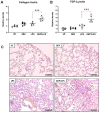Diesel Exhaust Particulates Enhances Susceptibility of LPS-Induced Acute Lung Injury through Upregulation of the IL-17 Cytokine-Derived TGF-β1/Collagen I Expression and Activation of NLRP3 Inflammasome Signaling in Mice
- PMID: 33419073
- PMCID: PMC7825418
- DOI: 10.3390/biom11010067
Diesel Exhaust Particulates Enhances Susceptibility of LPS-Induced Acute Lung Injury through Upregulation of the IL-17 Cytokine-Derived TGF-β1/Collagen I Expression and Activation of NLRP3 Inflammasome Signaling in Mice
Abstract
Diesel exhaust particulates (DEP) adversely affect the respiratory system and exacerbate lung diseases, resulting in high mortality rates. However, its pathogenesis is complicated, and the mechanisms involved are incompletely understood. We investigated the effects of DEP pre-exposure on lipopolysaccharide (LPS)-induced acute lung injury (ALI) and identified the roles of interleukin (IL)-17 in mice. Mice were divided into vehicle control, DEP, LPS, and DEP pre-exposed and LPS-instilled groups. Pre-exposure to DEP enhanced the number of total cells, neutrophils, and lymphocytes in the BAL fluid of LPS-instilled mice. Pre-exposure to DEP synergistically exacerbated pulmonary acute lung inflammation and granulomatous inflammation/pulmonary fibrosis, concomitant with the enhanced expression of inflammatory cytokines in the BAL fluid and of collagen I and TGF-β1 in the lungs of LPS-instilled mice. The number of TGF-β1-positive cells in the DEP pre-exposed and LPS-instilled group was higher than that in the LPS group. The expression of NLR family pyrin domain containing 3 (NLRP3) inflammasome components was markedly increased in the DEP pre-exposed and LPS-instilled group. IL-17 levels in the BAL fluid and IL-17-positive cells in the lungs were significantly increased by pre-exposure to DEP in the LPS-induced group compared to that in the DEP or LPS group. These results suggest that DEP predominantly contributes to fibrotic lung disease in LPS-related acute lung injury by upregulating IL-17 cytokine-mediated collagen I and TGF-β1 and, at least in part, by activating LPS-induced NLRP3 inflammasome signaling. The study should be useful in devising better strategies for prevention and management of ALI.
Keywords: IL-17; NLRP3; TGF-β1; acute lung injury; diesel exhaust particulate; lung fibrosis.
Conflict of interest statement
The authors declare no conflict of interest.
Figures







Similar articles
-
Pirfenidone ameliorates lipopolysaccharide-induced pulmonary inflammation and fibrosis by blocking NLRP3 inflammasome activation.Mol Immunol. 2018 Jul;99:134-144. doi: 10.1016/j.molimm.2018.05.003. Epub 2018 May 26. Mol Immunol. 2018. PMID: 29783158
-
CORM-2 inhibits TXNIP/NLRP3 inflammasome pathway in LPS-induced acute lung injury.Inflamm Res. 2016 Nov;65(11):905-915. doi: 10.1007/s00011-016-0973-7. Epub 2016 Jul 13. Inflamm Res. 2016. PMID: 27412237
-
The activation of NLRP3-inflammsome by stimulation of diesel exhaust particles in lung tissues from emphysema model and RAW 264.7 cell line.Korean J Intern Med. 2017 Sep;32(5):865-874. doi: 10.3904/kjim.2016.033. Epub 2017 Aug 18. Korean J Intern Med. 2017. PMID: 28814068 Free PMC article.
-
Linking NLRP3 inflammasome and pulmonary fibrosis: mechanistic insights and promising therapeutic avenues.Inflammopharmacology. 2024 Feb;32(1):287-305. doi: 10.1007/s10787-023-01389-5. Epub 2023 Nov 22. Inflammopharmacology. 2024. PMID: 37991660 Review.
-
The Role of the NLRP3 Inflammasome and Programmed Cell Death in Acute Liver Injury.Int J Mol Sci. 2023 Feb 4;24(4):3067. doi: 10.3390/ijms24043067. Int J Mol Sci. 2023. PMID: 36834481 Free PMC article. Review.
Cited by
-
Emerging Insights into the Impact of Air Pollution on Immune-Mediated Asthma Pathogenesis.Curr Allergy Asthma Rep. 2022 Jul;22(7):77-92. doi: 10.1007/s11882-022-01034-1. Epub 2022 Apr 8. Curr Allergy Asthma Rep. 2022. PMID: 35394608 Free PMC article. Review.
-
Comparable Response Following Exposure to Biodiesel and Diesel Exhaust Particles in Advanced Multicellular Human Lung Models.Toxics. 2023 Jun 14;11(6):532. doi: 10.3390/toxics11060532. Toxics. 2023. PMID: 37368632 Free PMC article.
-
Proteomic analysis reveals activation of platelet- and fibrosis-related pathways in hearts of ApoE-/- mice exposed to diesel exhaust particles.Sci Rep. 2023 Dec 19;13(1):22636. doi: 10.1038/s41598-023-49790-y. Sci Rep. 2023. PMID: 38114606 Free PMC article.
-
Deconvolution of multiplexed transcriptional responses to wood smoke particles defines rapid aryl hydrocarbon receptor signaling dynamics.J Biol Chem. 2021 Oct;297(4):101147. doi: 10.1016/j.jbc.2021.101147. Epub 2021 Sep 11. J Biol Chem. 2021. PMID: 34520756 Free PMC article.
-
Establishment of an artificial particulate matter-induced lung disease model through analyzing pathological changes and transcriptomic profiles in mice.Sci Rep. 2023 Apr 12;13(1):5955. doi: 10.1038/s41598-023-29919-9. Sci Rep. 2023. PMID: 37045933 Free PMC article.
References
-
- Strosnider H.M., Chang H.H., Darrow L.A., Liu Y., Vaidyanathan A., Strickland M.J. Age-specific associations of ozone and fine particulate matter with respiratory emergency department visits in the United States. Am. J. Respir. Crit. Care Med. 2019;199:882. doi: 10.1164/rccm.201806-1147OC. - DOI - PubMed
Publication types
MeSH terms
Substances
Grants and funding
LinkOut - more resources
Full Text Sources
Other Literature Sources

